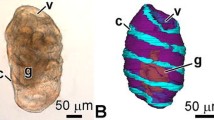Summary
In the mucosal epithelium of the digestive tract of two marine teleost bony fish, one cartilaginous fish, one cyclostome, and in that of two of three representatives of deuterostomian invertebrates studied, endocrine cells of open type were found, exhibiting immunoreactivity with antisera against C-terminal sequences of mammalian neurotensin and of the structurally closely related amphibian neurohormonal peptide xenopsin.
From these observations, and from those of previous studies, it is suggested that neurotensin cells do not occur in the digestive tract mucosa until at the evolutionary level of the more highly developed deuterostomian invertebrates. Three evolutionary stages seem to exist in the distribution pattern. The first stage, characterized by few, widely scattered cells, is found in the uro- and cephalochordates, the cyclostomes, the cartilaginous fish, and the stomachless bony fish. In the second stage, comprising the remaining submammalian classes, including more highly developed bony fish, the typical distribution pattern is that of numerous neurotensin immunoreactive cells in the antrum, pylorus, and duodenum. The final stage of neurotensin evolution is found in higher mammals and is characterized by a great density of neurotensin immunoreactive cells in the ileum.
Similar content being viewed by others
References
Carraway RE (1979) Neurotensin and related substances. In: Jaffe BM, Behrman HR (eds) Methods of Hormone Radioimmunoassay, Academic Press, New York, pp 139–169
Carraway RE, Bhatnagar YM (1980) Immunochemical characterization of neurotensin-like peptides in chicken. Peptides 1:159–165
El-Salhy M, Abou-El-Ela R, Falkmer S, Grimelius L, Wilander E (1980) Immunohistochemical evidence of gastro-entero-pancreatic neurohormonal peptides of vertebrate type in the nervous system of the larva of a dipteran insect, the flowerfly, Eristalis aeneus. Regulatory Peptides (in press)
Falkmer S, Emdin SO, Östberg Y, Mattisson A, Johansson-Sjöbeck M-L, Fänge R (1976) Tumor pathology of the hagfish, Myxine glutinosa, and the river lamprey, Lampetra fluviatilis. A lightmicroscopical study with particular reference to the occurrence of primary liver carcinoma, islet-cell tumors, and epidermoid cysts of the skin. Progr Exp Tumor Res 20:217–250
Falkmer S, Elde RP, Hellerström C, Petersson B, Efendić S, Fohlman J, Siljevall J-B (1977) Some phylogenetic aspects on the occurrence of somatostatin in the gastro-entero-pancreatic endocrine system. A histological and immunocytochemical study, combined with quantitative, radioimmunological assays of tissue extracts. Arch Histol Jpn 40:99–117
Falkmer S, Elde RP, Hellerström D, Petersson B (1978) Phylogenetic aspects of somatostatin in the gastroenteropancreatic (GEP) endocrine system. Metabolism 27:1193–1196
Falkmer S, Carraway RE, El-Salhy M, Emdin SO, Grimelius L, Rehfeld JF, Reinecke M, Schwartz TFW (1980) Phylogeny of the GEP neuroendocrine system. A review with special reference to the occurrence of CCK-like and neurotensin-like polypeptides in lower vertebrates and invertebrates. In: Grossman MI, Brazier MA, Lechago J (eds) Cellular Basis of Chemical Messengers in the Digestive System. UCLA Forum Med Sci 23:00–00
Frigerio B, Ravazola M, Ito S, Buffa R, Capella C, Solcia E, Orci L (1977) Histochemical and ultrastructural identification of neurotensin cells in the dog ileum. Histochemistry 54:123–131
Helmstaedter V, Taugner C, Feurle GE, Forssmann WG (1977) Localization of neurotensin-immunoreactive cells in the small intestine of man and various mammals. Histochemistry 53:35–41
Orci L, Baetens O, Rufener C, Brown M, Vale W, Guillemin R (1976) Evidence for immunoreactive neurotensin in dog intestinal mucosa. Life Sci 19:559–562
Reinecke M, Almasan K, Carraway RE, Helmstaedter V, Forssmann WG (1980a) Distribution patterns of neurotensin-like immunoreactive cells in the gastro-intestinal tract of higher vertebrates. Cell Tissue Res 205:383–395
Reinecke M, Carraway RE, Falkmer S, Forssmann WG (1980b) Phylogenesis of neurotensin-like immunoreactive gut cells. Third International Symposium on Gastrointestinal Hormones, Cambridge, (abstr)
Sternberger LA (1974) Immunocytochemistry. Englewood Cliffs, NJ, USA, Prentice-Hall
Sundler F, Alumets J, Håkanson R, Carraway RE, Leeman SE (1977a) Ultrastructure of the gut neurotensin cell. Histochemistry 53:25–34
Sundler F, Håkanson R, Hammer RA, Alumets J, Carraway RE, Leeman SE, Zimmerman EA (1977b) Immunohistochemical localization of neurotensin in endocrine cells of the gut. Cell Tissue Res 178:313–322
Van Noorden S, Falkmer S (1980) Gut-islet endocrinology — Some evolutionary aspects. Invest Cell Pathol 3:21–36
Author information
Authors and Affiliations
Additional information
Dedicated to Prof. Dr. J. Staubesand on the occasion of this 60th birthday
Rights and permissions
About this article
Cite this article
Reinecke, M., Carraway, R.E., Falkmer, S. et al. Occurrence of neurotensin-immunoreactive cells in the digestive tract of lower vertebrates and deuterostomian invertebrates. Cell Tissue Res. 212, 173–183 (1980). https://doi.org/10.1007/BF00233953
Accepted:
Issue Date:
DOI: https://doi.org/10.1007/BF00233953




